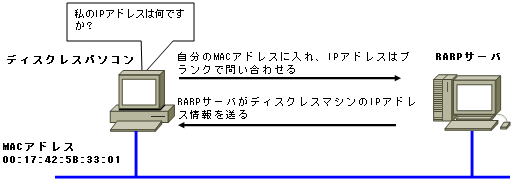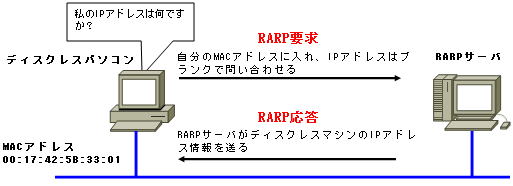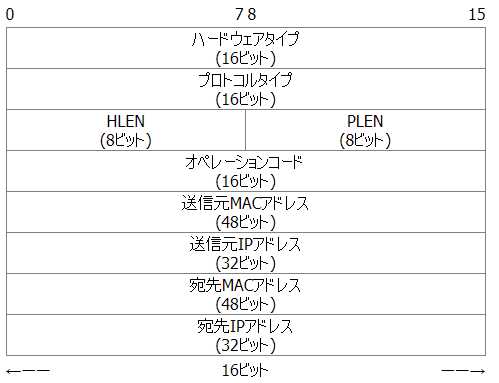RARP
RARP(Reverse Address Resolution Protocol)とは、ARPと逆の動作をするプロトコルです。
ARPは、IPアドレスからMACアドレスを取得しますが、RARPは、MACアドレスから、IPアドレスを取得します。 RARPは、主にディスクレスパソコンのようなIPアドレスを保存することができない端末が使用します。
ディスクレスパソコンは、IPアドレスを保存できるハードを持たないので、ネットワークに参加する段階では、自分のMACアドレスしか分からないことになります。

そこで、次の手順を使って自分のIPアドレスを取得します。
- 自分のMACアドレス、自分のIPアドレスはにブランクを入れたRARP要求パケットを、ブロードキャストアドレスで送出する。
- RARPサーバが、RARP要求パケットを受け取り、問い合わせのあったMACアドレスに対応するIPアドレスを一覧から探し出す。
- 問合せのあったディスクレスパソコンにRARP応答を返す。このパケットには、MACアドレスと発見したIPアドレスが書き込まれている。
RARPは、MACアドレスから、IPアドレスを取得します。
RARPの動作は、次の2つのやり取りからなります。
RARP要求
自分のMACアドレス、自分のIPアドレスはにブランクを入れたパケットを、ブロードキャストアドレスで送出する。
RARP応答
RARPサーバが、RARP要求の送信元に、割り当てるIPアドレスが書き込んだパケットを送信する。

RARPヘッダの構造
RARPヘッダ構造は、ARPヘッダと共通です。オペレーションコードで、使い分けるようになっています。
※イーサネットの場合

オペレーションコード(ARP/RARP)
ARPの動作の種類を表すためのコードが入る。
| コード | 動作 |
| 1 | ARP要求 |
| 2 | ARP応答 |
| 3 | RARP要求 |
| 4 | RARP応答 |
RARPで得られる情報は、IPアドレスだけです。サブネットマスクやゲートウェイアドレス、DNSサーバアドレスなど今日のIPコンフィグに欠かせない情報を得ることができません。
現在では、より機能の充実したBOOTPやDHCPによる自動設定が主流となっています。
